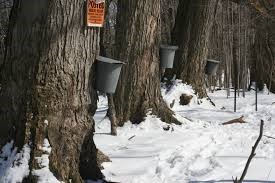Naturalist Korey shares some fun facts about how sap becomes the syrup that makes our breakfasts delicious.
 For many, maple syrup is a common breakfast condiment. Which is produced by collection sap from sugar maples (Acer saccharum), Wisconsin’s state tree, into the more concentrated form of syrup. As winter gives way to spring “sugarbushes” or forest managed for maple syrup is tapped by the hundreds in commercially and family-run “sugarbushes” across the state, northeastern states and eastern Canada. For a number of family-run farms, they have been operating for up to four generations to produce maple syrup for extra income, gifts or family use. It is all hands on deck when it comes to collecting sap to make maple syrup for even small-scale non-commercial sugarbushes as a family, extended family or close friends help with collecting and boiling the sap. As it takes approximately 40 gallons of sap to produce one gallon of syrup. Also, several school districts will take students to sugarbushes so they can learn how to collect and process the sap. The Ojibwe of Wisconsin has harvested sap for cultural subsistence for centuries.
For many, maple syrup is a common breakfast condiment. Which is produced by collection sap from sugar maples (Acer saccharum), Wisconsin’s state tree, into the more concentrated form of syrup. As winter gives way to spring “sugarbushes” or forest managed for maple syrup is tapped by the hundreds in commercially and family-run “sugarbushes” across the state, northeastern states and eastern Canada. For a number of family-run farms, they have been operating for up to four generations to produce maple syrup for extra income, gifts or family use. It is all hands on deck when it comes to collecting sap to make maple syrup for even small-scale non-commercial sugarbushes as a family, extended family or close friends help with collecting and boiling the sap. As it takes approximately 40 gallons of sap to produce one gallon of syrup. Also, several school districts will take students to sugarbushes so they can learn how to collect and process the sap. The Ojibwe of Wisconsin has harvested sap for cultural subsistence for centuries.
Not only does maple syrup production have a cultural significance in Wisconsin but it also has an economic impact. Wisconsin is the fourth largest maple syrup produce according to the National Agricultural Statistic Service. Though there is little scientific research don any family who runs sugarbush can tell you weather plays a critical role in the production of maple syrup. From fall soil moisture, win, spring soil moisture or humidity plays a role in the sugarbush’s success. The best conditions for sugaring are cool nights just below freezing and warm days in the upper 40s F. Due to the change in temperature it causes a shift in pressures outside of the tree which causes the sap to flow throughout the tree and out open wounds, such as tap hole.



